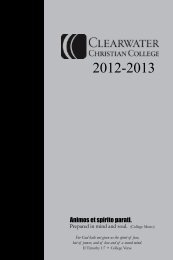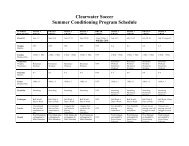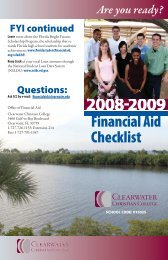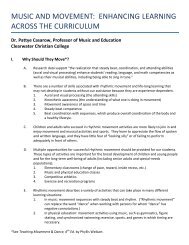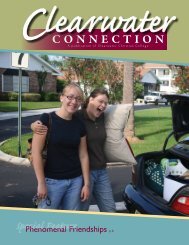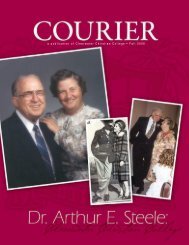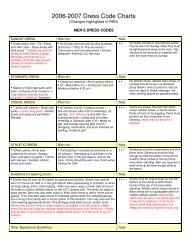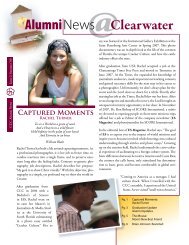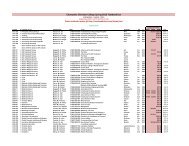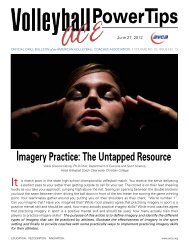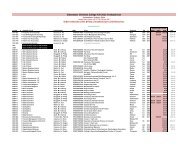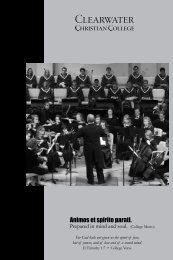101 Ways to Enrich Your Teaching with the Arts - Clearwater ...
101 Ways to Enrich Your Teaching with the Arts - Clearwater ...
101 Ways to Enrich Your Teaching with the Arts - Clearwater ...
- No tags were found...
You also want an ePaper? Increase the reach of your titles
YUMPU automatically turns print PDFs into web optimized ePapers that Google loves.
63 Science<br />
Social Studies<br />
64 Language<br />
<strong>Arts</strong><br />
Singing<br />
Playing<br />
Painting<br />
Listening<br />
Drawing<br />
Sense of Hearing<br />
Mexico<br />
Creative Writing<br />
65 Ma<strong>the</strong>matics Drawing Solving Abstract<br />
Concepts<br />
The students will explore <strong>the</strong> sounds in <strong>the</strong> classroom <strong>to</strong> utilize <strong>the</strong>ir<br />
sense of hearing. Taking turns in small groups, <strong>the</strong> students will tap<br />
different items in <strong>the</strong> classroom <strong>to</strong> hear <strong>the</strong> differences in <strong>the</strong> sound.<br />
Categorize sounds by terms such as metal, plastic, wood, and so forth.<br />
Have all <strong>the</strong> students bring in a small <strong>to</strong> medium sized bucket or<br />
container (KFC bucket, Cool Whip or plastic ice cream container, etc.).<br />
Each child should also have two pencils for drum sticks. Students can<br />
paint <strong>the</strong>ir “drums” <strong>with</strong> bright colors, decorating <strong>the</strong>m <strong>with</strong> a Latin flare.<br />
(Show examples.) As <strong>the</strong>y paint, have <strong>the</strong>m listen <strong>to</strong> <strong>the</strong> Christmas song<br />
by José Feliciano, “Feliz Navidad.” Talk about what Christmas in Mexico is<br />
like. When <strong>the</strong>y are ready, have <strong>the</strong>m sing and play rhythm patterns <strong>with</strong><br />
<strong>the</strong> recording. (See Appendix.)<br />
Use <strong>the</strong> “Music, Art, and Writing Worksheet” (see Appendix) as <strong>the</strong><br />
students listen <strong>to</strong> musical examples that are “classics” – such as “March”<br />
from <strong>the</strong> Nutcracker (Tchaikovsky), “Flight of <strong>the</strong> Bumble Bee” (Rimsky-<br />
Korsakov), “The Syncopated Clock” (Anderson), “Für Elise” (Beethoven),<br />
“Hoedown” from Rodeo (Copland), and “The Little Train of Caipira” (Villa-<br />
Lobos). You might <strong>to</strong> keep <strong>the</strong> title a secret at first <strong>to</strong> prevent leading <strong>the</strong><br />
students initially.<br />
Solve abstract concepts through drawing and renderings. Illustrate<br />
ma<strong>the</strong>matical problems in weight, balance, measurement, geometry, and<br />
<strong>the</strong>ir solutions.<br />
66 Bible Painting Creation: Day 4 Use DGA 47 Van Gogh Starry Night <strong>to</strong> have <strong>the</strong> students create a painting<br />
depicting Day 4 of Creation in <strong>the</strong> style of Vincent van Gogh.<br />
67 Social Studies Listening<br />
Moving<br />
Singing<br />
American Studies:<br />
Patriotism<br />
“The Stars and Stripes Forever” is <strong>the</strong> best known and most often<br />
performed march written for band. It is so popular in <strong>the</strong> United States<br />
that it is often included in <strong>the</strong> list of American National Music and is<br />
called our official National March. This piece is easy for <strong>the</strong> children <strong>to</strong><br />
march. The tempo is steady and in a simple 2 meter. Have <strong>the</strong>m wave<br />
small flags as <strong>the</strong>y march and teach <strong>the</strong> words <strong>to</strong> <strong>the</strong> trio section so <strong>the</strong>y<br />
can sing along. (See Appendix.)<br />
68 Science Singing<br />
Moving<br />
69 Language<br />
<strong>Arts</strong><br />
Poetry<br />
Listening<br />
70 Ma<strong>the</strong>matics Drawing<br />
Painting<br />
71 Bible Drawing<br />
Painting<br />
The Body<br />
The Sonnet<br />
Dividing Spaces<br />
We Are Fearfully<br />
and Wonderfully<br />
Made; God Loves<br />
Us<br />
Teach “Heel and Toe Polka” (Chimes of Dunkirk). You can vary <strong>the</strong><br />
repetitions <strong>with</strong> “Arm and Head,” “Hand and Elbow,” “Tummy and Hip,”<br />
etc. Let <strong>the</strong> children come up <strong>with</strong> two body parts that <strong>the</strong>y will <strong>to</strong>uch at<br />
that point in <strong>the</strong> song.<br />
Sing and move <strong>to</strong> “Chee Chee Cha” (Down in <strong>the</strong> Valley).<br />
Sing and move <strong>to</strong> “Razzama Tazzama” (Down in <strong>the</strong> Valley).<br />
Sing and move <strong>to</strong> “Looby Loo” (See Appendix.)<br />
Vivaldi used poetry <strong>to</strong> inspire his writing of The Four Seasons. See <strong>the</strong><br />
Appendix for <strong>the</strong> “Spring Sonnet.” As <strong>the</strong> students listen <strong>to</strong> “Spring” have<br />
<strong>the</strong>m identify <strong>the</strong> musical picture of <strong>the</strong> words of <strong>the</strong> sonnet. Extend <strong>the</strong><br />
lesson by having <strong>the</strong> students write <strong>the</strong>ir own sonnet about <strong>the</strong>ir favorite<br />
season of <strong>the</strong> year.<br />
Divide spaces and areas <strong>to</strong> create optical designs, such as artists use in<br />
optical art. See Vasarély Dizzy Op Art (DGA 92) for instructions.<br />
When teaching how we are uniquely made by God and that He loves each<br />
of us, use Max Lucado’s book Just in Case You Ever Wonder <strong>to</strong> extend <strong>the</strong><br />
lesson. Then use DGA p. 80 Kahlo Special Self-Portrait <strong>to</strong> guide <strong>the</strong><br />
students in making a self portrait.<br />
8



